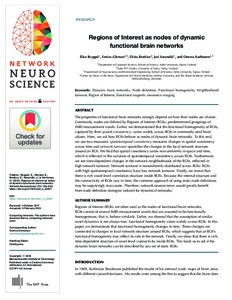Regions of Interest as nodes of dynamic functional brain networks
Elisa Ryyppö; Enrico Glerean; Elvira Brattico; Jari Saramäki; Onerva Korhonen
Regions of Interest as nodes of dynamic functional brain networks
Elisa Ryyppö
Enrico Glerean
Elvira Brattico
Jari Saramäki
Onerva Korhonen
MIT PRESS
Julkaisun pysyvä osoite on:
https://urn.fi/URN:NBN:fi-fe2021042720441
https://urn.fi/URN:NBN:fi-fe2021042720441
Tiivistelmä
The properties of functional brain networks strongly depend on how their nodes are chosen. Commonly, nodes are defined by Regions of Interest (ROIs), predetermined groupings of fMRI measurement voxels. Earlier, we demonstrated that the functional homogeneity of ROIs, captured by their spatial consistency, varies widely across ROIs in commonly used brain atlases. Here, we ask how ROIs behave as nodes of dynamic brain networks. To this end, we use two measures: spatiotemporal consistency measures changes in spatial consistency across time and network turnover quantifies the changes in the local network structure around an ROI. We find that spatial consistency varies non-uniformly in space and time, which is reflected in the variation of spatiotemporal consistency across ROIs. Furthermore, we see time-dependent changes in the network neighborhoods of the ROIs, reflected in high network turnover. Network turnover is nonuniformly distributed across ROIs: ROIs with high spatiotemporal consistency have low network turnover. Finally, we reveal that there is rich voxel-level correlation structure inside ROIs. Because the internal structure and the connectivity of ROIs vary in time, the common approach of using static node definitions may be surprisingly inaccurate. Therefore, network neuroscience would greatly benefit from node definition strategies tailored for dynamical networks.
Kokoelmat
- Rinnakkaistallenteet [27094]
